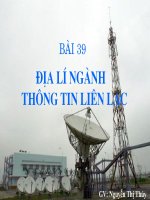Nén Video thông tin liên lạc P1
Bạn đang xem bản rút gọn của tài liệu. Xem và tải ngay bản đầy đủ của tài liệu tại đây (186.5 KB, 9 trang )
1
Introduction
1.1 Background
Both the International Standardisation Organisation (ISO) and the International
Telecommunications Union (ITU) standardisation bodies have been releasing
recommendations for universal image and video coding algorithms since 1985.
The first image coding standard, namely JPEG (Joint Picture Experts Group), was
released by ISO in 1989 and later by ITU-T as a recommendation for still image
compression. In December 1991, ISO released the first draft of a video coding
standard, namely MPEG-1, for audiovisual storage on CD-ROM at 1.5—2 Mbit/s.
In 1990, CCITT issued its first video coding standard which was then, in 1993,
subsumed into an ITU-T published recommendation, namely ITU-T H.261, for
low bit rate communications over ISDN networks at p ; 64 kbit/s. ITU-T H.262,
alternatively known as MPEG-2, was then released in 1994 as a standard coding
algorithm for HDTV applications at 4—9 Mbit/s. Then, in 1996, standardisation
activities resulted in releasing the first version of a new video coding standard,
namely ITU-T H.263, for very low bit rate communications over PSTN networks
at less than 64 kbit/s. Further work on improving the standard has ended up with a
number of annexes that have produced more recent and comprehensive versions of
the standard, namely H.263; and H.263;; in 1998 and 1999 respectively. In
1998, the ISO MPEG (Motion Picture Experts Group) AVT (Audio Video Trans-
port) group put forward a new coding standard, namely MPEG-4, for mobile
audiovisual communications. MPEG-4 was the first coding algorithm that used
the object-based strategy in its layering structure as opposed to the block-based
frame structure in its predecessors. In March 2000, the standardisation sector of
ISO published the most recent version of a standard recommendation, namely
JPEG-2000 for still picture compression. Most of the aforementioned video codi-
ng algorithms have been adopted as the standard video codecs used in contempor-
ary multimedia communication standards such as ITU-T H.323 and H.324 for the
provision of multimedia communications over packet-switched and circuit-
switched networks respectively. This remarkable evolution of video coding tech-
nology has underlined the development of a multitude of novel signal compression
Compressed Video Communications
Abdul Sadka
Copyright © 2002 John Wiley & Sons Ltd
ISBNs:0-470-84312-8(Hardback);0-470-84671-2(Electronic)
techniques that aimed to optimise the compression efficiency and quality of service
of standard video coders. In this book, we put at the disposal of readers a
comprehensive but simple explanation of the basic principles of video coding
techniques employed in this long series of standards. Emphasis is placed on the
major building blocks that constitute the body of the standardised video coding
algorithms. A large number of tests are carried out and included in the book to
enable the readers to evaluate the performance of the video coding standards and
establish comparisons between them where appropriate, in terms of their coding
efficiency and error robustness.
From a network perspective, coded video streams are to be transmitted over a
variety of networking platforms. In certain cases, these streams are required to
travel across a number of asymmetric networks until they get to their final
destination. For this reason, the coded video bit streams have to be transmitted in
the form of packets whose structure and size depend on the underlying transport
protocols. During transmission, these packets and the enclosed video payload are
exposed to channel errors and excessive delays, hence to information loss. Lost
packets impair the reconstructed picture quality if the video decoder does not take
any action to remedy the resulting information loss. This book covers a whole
range of error handling mechanisms employed in video communications and
provides readers with a comprehensive analysis of error resilience techniques
proposed for contemporary video coding algorithms. Moreover, this book pro-
vides the readers with a complete coverage of the quality of service issues asso-
ciated with video transmissions over mobile networks. The book addresses the
techniques employed to optimise the quality of service for the provision of real-
time MPEG-4 transmissions over GPRS radio links with various network condi-
tions and different error patterns.
On the other hand, to allow different video coding algorithms to interoperate, a
heterogeneous video transcoder must be employed to modify the bit stream
generated by the source video coder in accordance with the syntax of the destina-
tion coder. Some heterogeneous video transcoders are enabled to operate in two
or more directions allowing incompatible streams to flow across 2 or more
networks for inter-network video communications. If both sender and receiver are
utilising the same video coding algorithm but are yet located on dissimilar
networks of different bandwidth characteristics, then a homogeneous video trans-
coder is required to adapt the information rate of flowing coded streams to the
available bandwidth of the destination network. Hybrid video transcoding algo-
rithms have both heterogeneous and homogeneous transcoding capabilities to
adapt the transmitted coded video streams to the destination network in terms of
both the end-user video decoding syntax and the destination network capacity
respectively. This book addresses the technologies underpinning both the homo-
geneous and heterogeneous transcoding algorithms and presents the solutions
proposed for the improvement of quality of service for both transcoding scenarios
in error-free and error-prone environments.
2
INTRODUCTION
1.2 Source Material
ITU has specified a number of test video sequences for use in the performance
evaluation process of its proposed video coding paradigms. In this book, we focus
most of the conducted tests and experiments onto six different conventional ITU
test head-and-shoulder sequences to verify the study made on the performance of
the presented video coding schemes and the efficiency of the corresponding error
control algorithms. These test sequences have been selected to reflect a wide range
of video sequences with different properties and behaviour. Foreman, Miss Amer-
ica, Carphone, Grandma, Suzie and Claire are the six sequences used throughout
the book to conduct a large number of experiments and produce subjective and
objective results. Other video sequences, such as Stefan and Harry for instance, are
used only sporadically throughout the book with minor emphasis placed on their
use and corresponding test results. All of the six chosen sequences represent a
head-and-shoulder type of scene with different contrast and activity. Foreman is
the most active scene of all since it includes a shaky background, high noise and a
fair amount of bi-directional motion of the foreground object. Claire and Grand-
ma are both typical head-and-shoulder sequences with uniform and stationary
background and minimal amount of activity confined to moving lips and flicker-
ing eyelids. Both Claire and Grandma are low motion video sequences with
moderate contrast and noise and a uniform background. Miss America is rather
more active than Claire and Grandma with the subject once moving her shoulders
before a static camera. Suzie is another head-and-shoulder video sequence with
high contrast and moderate noise. It contains a fast head motion with the subject,
being the foreground, holding a telephone handset with a stationary and plain-
textured background. The carphone sequence shows a moving background with
fair details. Though not a typical head-and-shoulder sequence, Carphone shows a
talking head in a moving vehicle with more motion in the foreground object and a
non-uniform changing background. All these sequences are in discrete video YUV
format with a decomposition ratio 4: 2: 0, a QCIF (Quadrature Common Inter-
mediate Format) resolution of 176 pixels by 144 lines and a temporal resolution
(frame rate) of 25 frames per second. Figure 1.1 depicts some original frames
extracted from each one of the six sequences.
1.3 Video Quality Assessment and Performance Evaluation
Since compression at low bit rates results in inevitable quality degradation, the
performance of video coding algorithms must be assessed with regard to the
quality of the reconstructed video sequence. Both subjective and objective
methods are usually adopted to evaluate the performance of video coding algo-
rithms. The decoded video quality can be measured by simply comparing the
1.3 VIDEO QUALITY ASSESSMENT AND PERFORMANCE EVALUATION
3
(a) Foreman (b) Claire
(c) Grandma (d) Miss America
e) ( Suzie (f) Carphone
Figure 1.1 Original frames of used ITU test sequences
original and reconstructed video sequences. Although the subjective evaluation of
decoded video quality is quite cumbersome compared to the calculation of nu-
merical values for the objective quality evaluation, it is still preferable especially
for low and very low bit rate compression because of the inconsistency between the
existing numerical quality measurements and the Human Visual System (HVS).
On the other hand, in error-prone environments, errors might corrupt the coded
4
INTRODUCTION
video stream in a way that causes a merge or split in the transmitted video frames.
In this case, using the objective numerical methods to compare the original and
reconstructed video sequences would incorporate some errors in associating the
peer frames (corresponding frames between the two sequences) in both sequences
with each other. This leads to an inaccurate evaluation of the coder performance.
A subjective measurement in this case would certainly yield a fairer and more
precise evaluation of the decoded video quality.
There are two broad types of subjective quality evaluation, namely rating scale
methods and comparison methods (Netravali and Limb, 1980). In the first method,
an overall quality rating is assigned to the image (usually the last frame of a video
sequence) by using one of several given categories. In the second method, a quality
impairment of a standard type is introduced to the original image until the viewer
decides the impaired and reference images are of equal quality. However, through-
out this book, pair comparison is used where the original sequence and decoded
sequence frames are displayed side by side for subjective quality evaluation.
Original sequence frames are used as reference to demonstrate the performance of
a video coding algorithm in error-free environments. However, when the aim is to
evaluate the performance of an error resilience technique, the original frames are
then replaced by error-free decoded ones since the improvement is then intended
to be shown on the error performance of the coder (decoded video quality in
error-prone environments) and not on its error-free compression efficiency.
The quality of the video sequence can also be measured by using some math-
ematical criteria such as signal-to-noise ratio (SNR), peak-to-peak signal-to-noise
ratio (PSNR) or mean-squared-error (MSE). These measurement criteria are
considered to be objective due to the fact that they rely on the pixel luminance and
chrominance values of the input and output video frames and do not include any
subjective human intervention in the quality assessment process. For image and
video, PSNR is preferred for objective measurements and is frequently used by the
video coding research community, although the other two criteria are still occa-
sionally used. PSNR and MSE are defined in Equations 1.1 and 1.2, respectively:
PSNR : 10 log
255
1
M ; N
+\
G
,\
H
[x(i, j) 9 xˆ (i, j)]
(1.1)
MSE :
1
M ; N
+\
G
,\
H
[x(i, j) 9 xˆ (i, j)] (1.2)
where M and N are the dimensions of the video frame in width and height
respectively, and x(i, j) and xˆ (i, j) are the original and reconstructed pixel luminance
or chrominance values at position (i, j).
Additionally, for a fair performance evaluation of a video coding algorithm, the
1.3 VIDEO QUALITY ASSESSMENT AND PERFORMANCE EVALUATION
5









